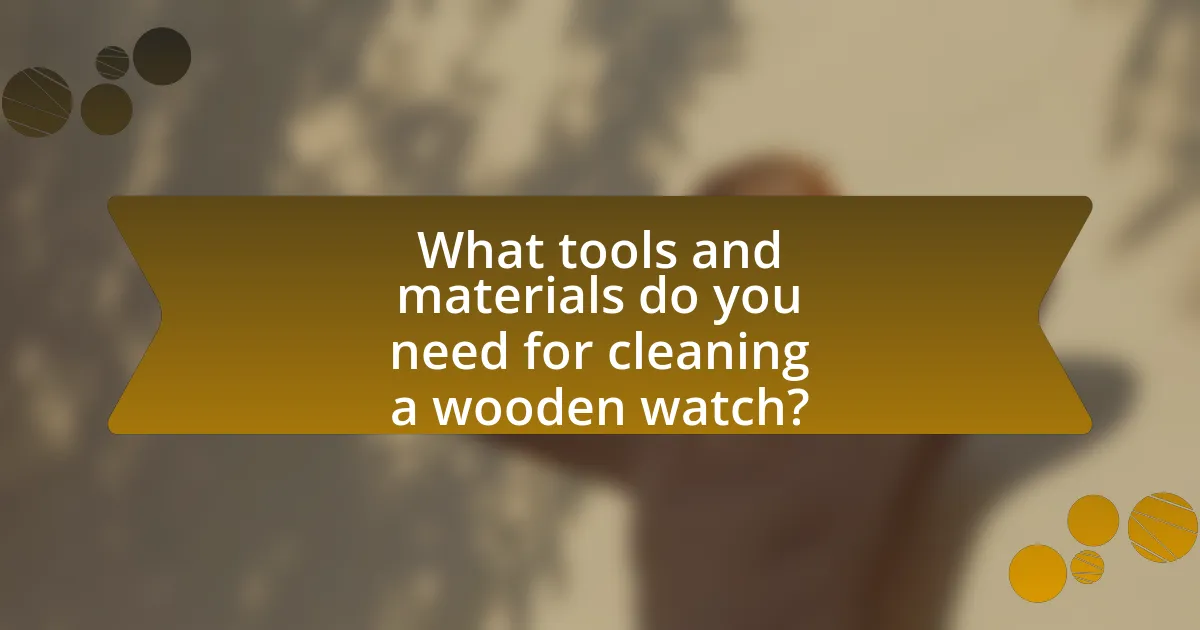The article focuses on effective cleaning methods for wooden watches, emphasizing the importance of using gentle techniques to preserve the wood’s integrity. It outlines the differences between cleaning wooden watches and other types, highlighting the materials typically used in their construction, such as bamboo and sandalwood. Key cleaning tools and safe solutions are discussed, along with best practices for maintaining the watch’s appearance and preventing damage. Additionally, the article addresses common challenges, troubleshooting tips for damage, and the significance of regular maintenance to ensure longevity and aesthetic appeal.

What is the best way to clean your wooden watch?
The best way to clean your wooden watch is to use a soft, lint-free cloth slightly dampened with water. This method effectively removes dirt and oils without damaging the wood finish. Avoid using harsh chemicals or soaking the watch, as these can lead to warping or discoloration. Regularly wiping the watch with a dry cloth can also help maintain its appearance and longevity.
How does cleaning a wooden watch differ from cleaning other types of watches?
Cleaning a wooden watch differs from cleaning other types of watches primarily due to the materials involved; wooden watches require gentler cleaning methods to avoid damaging the wood. Unlike metal or plastic watches that can withstand harsher cleaning agents and methods, wooden watches are sensitive to moisture and chemicals, which can lead to warping or discoloration. For instance, while metal watches can be cleaned with water and soap, wooden watches should be wiped with a damp cloth and a mild soap solution, ensuring that excess moisture is avoided. This approach is essential because prolonged exposure to water can compromise the integrity of the wood, unlike metal watches that are often water-resistant.
What materials are typically used in wooden watches?
Wooden watches are typically made from various types of wood, including bamboo, sandalwood, maple, walnut, and cherry. These materials are chosen for their aesthetic appeal, durability, and lightweight properties. For instance, bamboo is known for its sustainability and strength, while sandalwood offers a distinct fragrance and rich color. The choice of wood affects not only the watch’s appearance but also its weight and comfort on the wrist.
Why is it important to use specific cleaning methods for wooden watches?
Using specific cleaning methods for wooden watches is crucial to prevent damage to the wood and maintain its integrity. Wooden watches are made from natural materials that can be sensitive to moisture, harsh chemicals, and abrasive cleaning techniques. For instance, using water or alcohol-based cleaners can cause the wood to swell, warp, or lose its finish. Additionally, improper cleaning can lead to discoloration or deterioration of the wood over time. Therefore, employing gentle, wood-safe cleaning methods ensures the longevity and aesthetic appeal of the watch, preserving both its functionality and appearance.
What are the common challenges when cleaning wooden watches?
Cleaning wooden watches presents several common challenges, primarily due to the material’s sensitivity to moisture and cleaning agents. Wooden watches can absorb water, leading to warping or damage, making it crucial to avoid excessive moisture during cleaning. Additionally, many cleaning products contain chemicals that can strip the wood’s natural oils, resulting in a dull appearance and potential cracking. The intricate designs and small crevices in wooden watches also make thorough cleaning difficult, as dirt and grime can accumulate in hard-to-reach areas. Finally, the risk of scratching the wood surface during cleaning is significant, necessitating the use of soft, non-abrasive materials to prevent damage.
How can moisture damage a wooden watch?
Moisture can damage a wooden watch by causing the wood to swell, warp, or crack. When wood absorbs moisture, it expands, which can lead to structural changes and misalignment of the watch components. Additionally, prolonged exposure to moisture can promote mold and mildew growth, further deteriorating the wood and affecting the watch’s appearance and functionality. Studies show that wood is hygroscopic, meaning it readily absorbs water, which underscores the importance of keeping wooden watches dry to maintain their integrity and longevity.
What risks are associated with using harsh chemicals on wooden watches?
Using harsh chemicals on wooden watches can lead to significant damage, including deterioration of the wood, loss of finish, and potential warping. The chemical composition of these substances can strip away protective coatings, making the wood more susceptible to moisture and environmental factors. For instance, solvents like acetone can break down the natural oils in the wood, resulting in a dry and cracked surface. Additionally, harsh chemicals can cause discoloration, altering the watch’s appearance permanently. Therefore, it is crucial to use gentle, wood-safe cleaning products to maintain the integrity and aesthetic of wooden watches.

What tools and materials do you need for cleaning a wooden watch?
To clean a wooden watch, you need a microfiber cloth, a soft-bristled toothbrush, mild soap, and water. The microfiber cloth effectively removes dust and fingerprints without scratching the wood, while the soft-bristled toothbrush helps to reach crevices and remove dirt. Mild soap mixed with water provides a gentle cleaning solution that does not harm the wood finish. Using these specific tools and materials ensures that the cleaning process is safe and effective, preserving the integrity of the wooden watch.
What cleaning solutions are safe for wooden watches?
Cleaning solutions that are safe for wooden watches include mild soap mixed with water, white vinegar diluted with water, and specialized wood cleaners. Mild soap effectively removes dirt without damaging the wood, while white vinegar acts as a natural disinfectant and can help eliminate odors. Specialized wood cleaners are formulated specifically for wooden items, ensuring they clean without causing harm. These solutions are recommended because they do not contain harsh chemicals that could strip the wood’s natural oils or finish, preserving the watch’s integrity and appearance.
How do natural cleaning solutions compare to commercial products?
Natural cleaning solutions are generally safer and more environmentally friendly compared to commercial products, which often contain harsh chemicals. Research indicates that natural ingredients like vinegar and baking soda can effectively clean surfaces without the toxic effects associated with many commercial cleaners. For instance, a study published in the Journal of Environmental Health found that natural cleaning agents can reduce indoor air pollution and improve overall air quality, while commercial products may contribute to respiratory issues due to volatile organic compounds (VOCs). Thus, while both types of cleaning solutions can be effective, natural options provide a healthier alternative for both users and the environment.
What tools should you avoid when cleaning a wooden watch?
Avoid using abrasive materials, harsh chemicals, and excessive water when cleaning a wooden watch. Abrasive materials can scratch the wood surface, while harsh chemicals can damage the finish and integrity of the wood. Excessive water can lead to swelling or warping of the wood, compromising the watch’s structure. These tools and methods are detrimental to maintaining the quality and longevity of a wooden watch.
What are the steps to effectively clean a wooden watch?
To effectively clean a wooden watch, follow these steps: First, gather a soft, lint-free cloth, mild soap, and water. Second, dampen the cloth with a mixture of mild soap and water, ensuring it is not overly wet. Third, gently wipe the wooden parts of the watch, avoiding excessive moisture to prevent damage. Fourth, use a dry part of the cloth to remove any soap residue and moisture. Finally, allow the watch to air dry completely before wearing it again. These steps ensure the watch remains in good condition while being cleaned.
How do you prepare your wooden watch for cleaning?
To prepare your wooden watch for cleaning, first, remove it from your wrist to prevent any accidental damage. Next, ensure that the watch is completely dry, as moisture can harm the wood. Additionally, take off any metal or leather components if possible, as these materials may require different cleaning methods. This preparation is essential because it minimizes the risk of damaging the wood during the cleaning process.
What techniques should you use to clean the watch without causing damage?
To clean a wooden watch without causing damage, use a soft, lint-free cloth slightly dampened with water to gently wipe the surface. Avoid using harsh chemicals or abrasive materials, as these can scratch or degrade the wood finish. Additionally, for deeper cleaning, a mixture of mild soap and water can be applied with a soft brush, ensuring that no moisture seeps into the wood. This method is effective because it minimizes the risk of water damage while maintaining the watch’s appearance.

How can you maintain your wooden watch after cleaning?
To maintain your wooden watch after cleaning, regularly apply a wood conditioner or oil specifically designed for wooden accessories. This practice helps to nourish the wood, preventing it from drying out and cracking. Additionally, store the watch in a cool, dry place away from direct sunlight to avoid warping and fading. Regularly check for any signs of wear or damage, and promptly address any issues to prolong the watch’s lifespan.
What are the best practices for preserving the finish of a wooden watch?
To preserve the finish of a wooden watch, regularly clean it with a soft, dry cloth to remove dust and moisture. This practice prevents buildup that can damage the wood’s finish. Additionally, avoid exposing the watch to extreme temperatures and direct sunlight, as these conditions can cause the wood to warp or fade. Using a specialized wood conditioner or oil every few months can also help maintain the finish by providing necessary moisture and protection. These methods are effective because they minimize wear and tear, ensuring the longevity of the watch’s aesthetic appeal.
How often should you clean your wooden watch to maintain its appearance?
You should clean your wooden watch every few months to maintain its appearance. Regular cleaning helps remove dirt, oils, and moisture that can accumulate over time, potentially damaging the wood and affecting its finish. Specifically, cleaning every three to six months is recommended, depending on usage and exposure to elements. This frequency ensures that the wood remains in good condition and retains its natural luster.
What protective measures can you take to prevent future damage?
To prevent future damage to a wooden watch, regularly apply a protective wood conditioner or oil specifically designed for wooden surfaces. This treatment helps maintain the wood’s natural moisture balance and prevents cracking or warping. Additionally, avoid exposing the watch to extreme temperatures, humidity, or direct sunlight, as these conditions can degrade the wood over time. Research indicates that maintaining a stable environment for wooden items significantly extends their lifespan and preserves their aesthetic quality.
What troubleshooting tips can help if your wooden watch shows signs of damage?
If your wooden watch shows signs of damage, first assess the type of damage, such as scratches, water exposure, or loose components. For scratches, gently buff the area with fine sandpaper or a soft cloth to restore the finish. If the watch has been exposed to water, dry it immediately and place it in a bowl of uncooked rice for 24 hours to absorb moisture. For loose components, carefully tighten screws or consult a professional for repairs. These methods are effective as they address common issues associated with wooden watches, ensuring longevity and maintaining aesthetics.
How can you address scratches or scuffs on a wooden watch?
To address scratches or scuffs on a wooden watch, use a fine-grit sandpaper or a specialized wood polish. Gently sand the scratched area in the direction of the wood grain to minimize further damage, and then apply the wood polish to restore the finish and luster. This method is effective because it removes the damaged layer of wood and allows for a smooth surface, ensuring the watch maintains its aesthetic appeal.
What should you do if your wooden watch has absorbed moisture?
If your wooden watch has absorbed moisture, immediately remove it from any wet environment and dry it gently with a soft, absorbent cloth. This action helps prevent further damage and warping of the wood. Additionally, place the watch in a dry area with good airflow, avoiding direct sunlight or heat sources, as these can cause the wood to crack. It is also advisable to monitor the watch for any signs of swelling or distortion, as prolonged moisture exposure can lead to irreversible damage.
